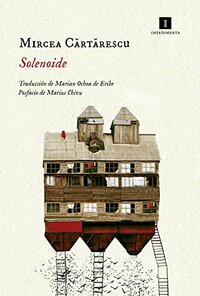Take a photo of a barcode or cover
No l'he acabat... Hi ha moments absolutament estel·lars, però les parts que no m'agraden no m'agraden gens ni mica. Una mica pedant i molt desagradable, acceptable en dosis petites però no per 800 pàgines! Potser estic fluixa, potser en un altre moment m'hauria encantat perquè, repeteixo, moments estel·laríssims que m'han encantat, però de moment he de deixar-ho estar. Potser hi tornaré. Qui sap. Estic molt decebuda amb el llibre i amb mi mateixa. :(
Truly a marvel of surrealist fiction. I once heard that the poet Charles Simic told his students that in order to be surreal, first it must be real. The Bucharest of Solenoid is one of the realest places in all of my reading experiences. I left the book feeling like I had experienced the city in a tactile way. And the city’s realness allows a space for everything else in this wild, weird, remarkable book. I’m not going to tell you anything about it except to say that I’m certain I will never forget many moments from this book. It’s strange and dense, but also very personable and accessible. It doesn’t have difficult or experimental prose, but a straightforward first person narrator. I recommend not reading anything beyond the blurb on the book (if that). Don’t try to find out what it’s about. Just open the cover and join the narrator and let the book unfold.
dark
slow-paced
Solenoid is an Eastern European version of Gravity's Rainbow, an immense paranoid web of personal fantasy and historical curiosity. Our narrator is a teacher of Romanian literature at a school in Bucharest. This story, his diary, slips back and forth from the mundane absurdity of his job, to the anomalies of his personal history, to a fantastic fugue of dreams and grand destinies.
Dividing these levels is unfair, impossible, but I must try. I enjoyed most the comedy of School 86, where classes are taught in rooms like √-5 Ω, the principal tells all the teachers that being married is worse than being hanged (only a little), and government ordered collection of glass and paper by the students creates a citywide black market where entire factories are devoted to producing junk paper that is immediately recycled and jars are worth more empty than full. Our narrator is terrified of his students, seeing them as an entirely different species, and also bemoans the physical abuse and rote recitation that passes for education at his school.
His own past is strange enough. He dreamed of being a writer, until his epic poem The Fall was brutally critiqued at a literary workshop. He had a twin who was abducted for medical experimentation when they were a year old, and then was raised as a girl by his mother for several years. He spent his childhood being injected with antibiotics, having his teeth drilled and filled, and in a bizarre tuburculosis sanitarium. Reality has always felt like a false shell, with dreams and the strange visitors within them being more real than the physical. Words are both ultimate truth and ultimate falseness. He was once married, but his wife went mad, or was slowly replaced by an alien being that looked just like her. Now his life is a rut, a handful of baby teeth, an increasing stack of ink-sodden journals.
This is all connected to Bucharest, which is described as a city created already ruined, a grand unified design like Brasilia or St. Petersburg, with the ravages of time built in. Bucharest rests atop of the solenoids, six copper braids with geomantic powers, one of which lies directly beneath the narrator's house. This is all connected to the historical Boole-Hinton-Voynich family. Of logician Boole's daughters, Alice Boole Stott made important advances in Charles Hinton's four-dimensional shapes, tesseracts which were a brief Victorian fad. Ethel Voynich wrote a novel, The Gadfley, which was popular in the Soviet Union, and moved in revolutionary circles. Her husband, bookseller Wilfrid Voynich, leant his name to the infamous undeciphered Voynich manuscript. This real history is linked to the fantastical, buildings that warp space and time, statutes that come to life, protest movements against the idea of death and suffering.
The writing is dense and lush, but the novel itself is like one of its impossible buildings, spiraling in to a revelation of darkness rather than light.
Dividing these levels is unfair, impossible, but I must try. I enjoyed most the comedy of School 86, where classes are taught in rooms like √-5 Ω, the principal tells all the teachers that being married is worse than being hanged (only a little), and government ordered collection of glass and paper by the students creates a citywide black market where entire factories are devoted to producing junk paper that is immediately recycled and jars are worth more empty than full. Our narrator is terrified of his students, seeing them as an entirely different species, and also bemoans the physical abuse and rote recitation that passes for education at his school.
His own past is strange enough. He dreamed of being a writer, until his epic poem The Fall was brutally critiqued at a literary workshop. He had a twin who was abducted for medical experimentation when they were a year old, and then was raised as a girl by his mother for several years. He spent his childhood being injected with antibiotics, having his teeth drilled and filled, and in a bizarre tuburculosis sanitarium. Reality has always felt like a false shell, with dreams and the strange visitors within them being more real than the physical. Words are both ultimate truth and ultimate falseness. He was once married, but his wife went mad, or was slowly replaced by an alien being that looked just like her. Now his life is a rut, a handful of baby teeth, an increasing stack of ink-sodden journals.
This is all connected to Bucharest, which is described as a city created already ruined, a grand unified design like Brasilia or St. Petersburg, with the ravages of time built in. Bucharest rests atop of the solenoids, six copper braids with geomantic powers, one of which lies directly beneath the narrator's house. This is all connected to the historical Boole-Hinton-Voynich family. Of logician Boole's daughters, Alice Boole Stott made important advances in Charles Hinton's four-dimensional shapes, tesseracts which were a brief Victorian fad. Ethel Voynich wrote a novel, The Gadfley, which was popular in the Soviet Union, and moved in revolutionary circles. Her husband, bookseller Wilfrid Voynich, leant his name to the infamous undeciphered Voynich manuscript. This real history is linked to the fantastical, buildings that warp space and time, statutes that come to life, protest movements against the idea of death and suffering.
The writing is dense and lush, but the novel itself is like one of its impossible buildings, spiraling in to a revelation of darkness rather than light.
Though not without its faults, Solenoid is a masterpiece of postmodernist ontological horror. Suburban Bucharest under Communist rule lends its perpetual physical and moral decay to the existential quest of a Romanian school teacher, with aborted dreams of literature and in a state of questionable physical and mental health. As he examines the defining episodes of his past a series of uncanny events slowly unfold, suggesting the possibility of an upcoming resolution to his obsessive search for meaning in general, and for what could have been had he decided to commit to literary career.
In this novel horror is both cosmic and microscopic, metaphysical and organic; it is hidden in plain sight and touches all. The protagonist himself does not seem to oppose the devastating horror, instead he embraces it, pursues it, ultimately growing from it. Not offering any resistance but never lacking resolve, he is taken on a journey, a non-linear pandemonium of the mundane and the horrific, that takes the reader off-guard by offering a bittersweet sense of solace, if not hope.
In its abundance and totality the novel might feel repetitive, disorientating and overwhelming at times, but it feels (mostly) intentional and rarely distracts from the reward of reading it to the end.
A striking achievement.
In this novel horror is both cosmic and microscopic, metaphysical and organic; it is hidden in plain sight and touches all. The protagonist himself does not seem to oppose the devastating horror, instead he embraces it, pursues it, ultimately growing from it. Not offering any resistance but never lacking resolve, he is taken on a journey, a non-linear pandemonium of the mundane and the horrific, that takes the reader off-guard by offering a bittersweet sense of solace, if not hope.
In its abundance and totality the novel might feel repetitive, disorientating and overwhelming at times, but it feels (mostly) intentional and rarely distracts from the reward of reading it to the end.
A striking achievement.
The greatest surrealist “novel” never written. One day I might write a real review, but any attempt will be a shoddy palimpsest that basks in its inadequacy to write on the prose.
Thought it was rather dense. Read the reviews. I could see it would only get worse
challenging
dark
funny
mysterious
sad
slow-paced
Plot or Character Driven:
Character
Strong character development:
Complicated
Loveable characters:
No
Diverse cast of characters:
Yes
Flaws of characters a main focus:
Complicated
Què es pot llegir després d'açò?
Cărtărescu ha acabat amb la literatura.
Cărtărescu ha acabat amb la literatura.
challenging
dark
mysterious
tense
slow-paced
Plot or Character Driven:
N/A
Strong character development:
Complicated
Loveable characters:
No
Diverse cast of characters:
Complicated
Flaws of characters a main focus:
Complicated









